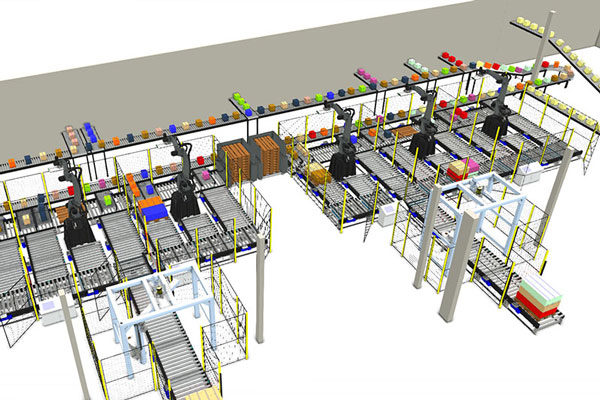Robotic palletisers and layer former palletisers are both types of automation equipment used in material handling and palletising processes within various industries, including manufacturing, logistics, and warehousing. Whilst they effectively serve the same purpose, they have distinct features, advantages, and disadvantages.
Robotic Palletiser:
- Robotic palletisers use robotic arms with various end-of-arm tools (EOAT) to pick up single or multiples of items, cases, or bags and stack them onto a pallet in a specific pattern.
- They offer high flexibility and adaptability since the robot’s programming can be changed to handle different product types and palletising patterns easily.
- Robotic palletisers are suitable for handling a wide range of products, sizes, and weights.
- They are ideal for businesses with diverse product lines or frequently changing packaging requirements.
- Robotic palletisers can also be integrated into other automation systems for material handling and packaging.
Robotic Palletiser Advantages:
- Flexibility and adaptability, can simultaneously palletise different product off multiple lines.
- Efficient handling of various products and patterns.
- Can be integrated with other systems.
- Reduced manual labour and increased productivity.
Robotic Palletiser Disadvantages:
- Initial setup and programming can be time-consuming if it is not an easy programming system.
- Programming expertise required if it is not an easy programming system.
Layer Former Palletiser:
- Layer formers are specialised machines designed to create complete product layers on pallets.
- They are typically used for uniform products that are palletised in consistent layers, such as cases or boxes of the same size and weight.
- Layer formers automate the process of creating layers by arranging products in a predetermined pattern.
- They are efficient for high-volume production lines with consistent packaging.
Layer Former Palletiser Advantages:
- High-speed and efficiency for uniform product palletising
- Sometimes more compact floor footprint than a robotic palletiser for high speeds
Layer Fromer Palletiser Disadvantages:
- Limited flexibility; not suitable for handling a variety of products or palletising patterns.
- Less adaptability to changing production requirements.
- May require manual adjustments for different product types.
- More moving parts and higher maintenance costs
- Often higher than a robotic palletising system
In summary, the choice between a robotic palletiser and a layer former palletiser depends on the specific needs and requirements of your production line:
- If you have a diverse range of products, frequently changing packaging patterns, or require flexibility in your palletising process, a robotic palletiser is a better choice.
- If your production involves high-volume, uniform products that are consistently palletised in specific patterns, a layer former palletiser can provide cost-effective automation.
Ultimately, the decision should be based on your production goals, budget, and the nature of your products. In some cases, a combination of both types of palletisers may be the most efficient solution.
If you would like to discuss your specific application in more detail, please contact us on 01223 499488 or helpline@granta-automation.co.uk.









Warning: Undefined variable $aria_req in /var/www/granta-automation.co.uk/news/wp-content/themes/twentyten/comments.php on line 81
Warning: Undefined variable $aria_req in /var/www/granta-automation.co.uk/news/wp-content/themes/twentyten/comments.php on line 86